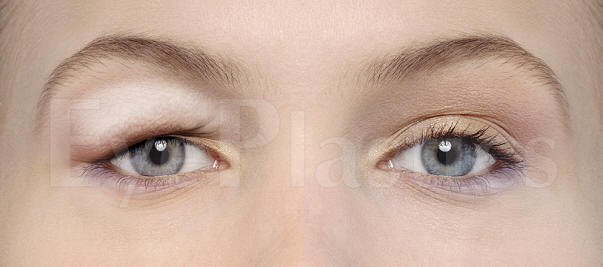Blepharoplasty Combined with Ptosis Repair
There are two 'main' surgeries that may possibly be performed on the upper eyelid.
- Ptosis is the medical term for drooping of the upper eyelid; it may possibly affect one or both eyes.

- Pseudoptosis is different from ptosis and refers to the situation when excess skin may possibly encroach on the eyelid; it may possibly affect one or both eyelids and is repaired by blepharoplastY

Thus the patient has two eyelid conditions that should be evaluated.
When you lift the skin (photograph on the right), once can see the patient has ptosis.
| Repair of Ptosis |
Removal of Excess Skin |
- Ptosis (Ptosis is sometimes referred to as Blepharoptosis. It refers to an eyelid which is droopy. This may possibly cause a loss of vision, especially while reading, headaches, and eyebrow strain.
- Surgery involves elevating the eyelid itself, either by a skin incision or from the back of the eyelid
|
- Pseudoptosis refers to the situation when excess skin causes a hooding, or blinders effect, limiting the peripheral visual field.
- Surgery is called a Blepharoplasty
- Surgery involves removing excess skin and fat from the eyelid
|
 |
 |
Repair the one or both of the eyelid muscles that has weakened resulting in a ptotic eyelid.
- Ptosis can be corrected via several different techniques.
-
- Repair of a droopy eyelid can be performed via an eyelid crease incision or from the inside of the eyelid (no skin incision), or if severe, via alternate suspension techniques
-
- Repair of ptosis & blepharoplasty are often performed at the same time.
|
Your droopy upper eyelids and droopy brows may possibly give you the appearance of being sleepy, tired and aging prematurely
- In adds to, this sagging, may possibly lead to brow/eyelid strain
-
- Eyelid surgery to improve the appearance of the eyelids is often called 'eyelift' or 'blepharoplasty'.
-
- This surgery can be performed on both the UPPER and on the LOWER eyelids.
|
 |
 |
 |
 |
- In the pre-operative photograph above, take note that there appears to be little, if any excess upper eyelid skin.
-
- Rather, the patient's superior visual field is limited by the position of the eyelid since it partially obstructs the pupil.
-
- The normal position of the upper eyelid is midway between superior limbus and the upper pupillary margin.
-
- When the edge of the upper eyelid falls, it may possibly block the upper field of your vision
|
- Removal of upper eyelid excess skin and fat (often cosmetic in nature and not covered by insurance).
-
- This is often called Pseudoptosis and is repaired by Blepharoplasty
-
- Repair of ptosis & blepharoplasty may possibly be performed at the same time.
|
| |
|

.png)







